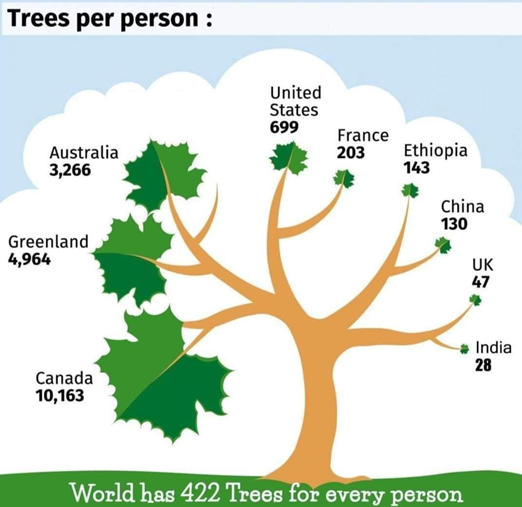CREATE THE SPACE FOR GOVERNANCE WITH A GREEN HEART
Relevance:
- GS 2 – Government policies and interventions for development in various sectors and issues arising out of their design and implementation.
- GS 3 – Conservation, environmental pollution and degradation, environmental impact assessment.
Why in the news?
- A new term begins for the government and the Lok Sabha, emphasizing the need for green concerns.
- Historically, no government has prioritized the environment, with the last one actively harming environmental interests in pursuit of ‘development.’
- Environment Ministers for over a dozen years have prioritized mining, oil, coal, highways, and power industries.
Need for Green Policies
- India faces severe environmental degradation that can only be halted by adopting green policies.
- Green policies are crucial even as India strives to become a middle-income economy.
- Urgent areas for addressing environmental concerns include:
- Policy reforms and stringent regulations
- Sustainable development practices
- Conservation of natural resources
- Reduction of industrial pollution
- Promotion of renewable energy sources
- Protection of biodiversity and ecosystems
India Needs to Acknowledge Greater Vulnerability
- India’s leadership frequently mentions climate change but takes limited action, primarily focusing on promoting the solar energy industry.
- Despite increasing energy consumption, no significant steps have been taken to reduce emissions.
- Remedial aspects of climate change, such as building resilience, ensuring food security, and providing access to essentials, have been deprioritized.
- Increasing occurrences of floods, famines, heatwaves, wildfires, water shortages, and droughts highlight the need for effective contingency plans.
- Measures needed to protect vulnerable populations and reduce harm include:
- Updating building guidelines for climate resilience
- Preserving natural storm barriers like mangrove forests
- Establishing funds for evacuation and rehabilitation
- The Ministry of Environment, Forest and Climate Change has recently neglected these essential tasks.
Key Environmental Concerns for India
Forest Cover
- India has one of the world’s lowest levels of green cover per capita with only 28 trees per person, compared to Canada’s 10,163 and China’s 130.
- Significant decline in important forest cover over the past 20 years.
- Urban forestry is severely lacking.
- Forest damage has been obscured by questionable accounting practices, including counting plantation forests and urban tree cover.
- The Forest (Conservation) Amendment Bill, 2023, hastily passed by the outgoing Parliament, needs to be rolled back and replaced with robust protections.
Unliveable Cities
- Major metropolitan areas like Delhi, Mumbai, and tier 2 and tier 3 cities in the Gangetic belt suffer from extreme air pollution, impacting residents’ health and lifespan.
- Cities like Bengaluru and Delhi face severe water shortages, with the poor queuing for hours for minimal water supply.
- Rivers such as the Adyar in Chennai and the Yamuna in Delhi have become polluted.
- Urbanization has led to the destruction of green spaces and water bodies, creating heat islands.
- Smaller cities face more manageable problems but need timely intervention to avoid crises.
- Only about 28% of sewage generated by Indian cities is treated, necessitating a major national overhaul of sewage treatment systems.
Destruction in the Himalayas
- Climate change has caused rapid glacier recession, with forecasts predicting up to 80% of their volume disappearing this century.
- Changes in rainfall and temperature patterns adversely affect water and food security in the mountains and much of North India.
- Government has ignored protests, such as those by Ladakhis demanding action.
- Wetlands and other marginal landscapes, crucial for biodiversity, face similar neglect.
Public Participation
- The government has historically refused to listen to stakeholders and affected persons.
- Environmental Impact Assessment (EIA) mechanisms have become mere formalities.
- Protests and criticisms are often ignored.
- The Char Dham Highway project is a case in point, causing significant environmental harm due to insufficient EIA processes.
- The sanctity of the EIA Notification of 2006 has been undermined by numerous amendments.
- EIA mechanisms need to be given statutory status to prevent sabotage.
Restore Genuine Conservation
- Greenwashing policies, driven by commercial interests, Green credits and compensatory afforestation have replaced genuine conservation efforts.
- Sustainable development does not mean that only commercially profitable steps may be taken by the government.
- Enforcement mechanisms and bodies need to be strengthened to ensure genuine environmental governance.
Need of the Hour
- These are not luxury concerns; they impact the survival and health of millions.
- The absence of these issues from the election manifestos of major political parties was bitterly disappointing.
- It is not too late to address these critical concerns.
- For the government to truly serve as the steward of the people, it must:
- Take a hard look at the physical health of the country.
- Prioritize environmental and public health issues.
- Implement effective and sustainable policies to safeguard the environment and public well-being.
Alternative articles
https://universalinstitutions.com/india-needs-to-bring-environment-issues-to-political-mainstream/
Mains question
Discuss the critical environmental challenges before India in conservation. Suggest measures for sustainable development and effective governance. (250 words)




